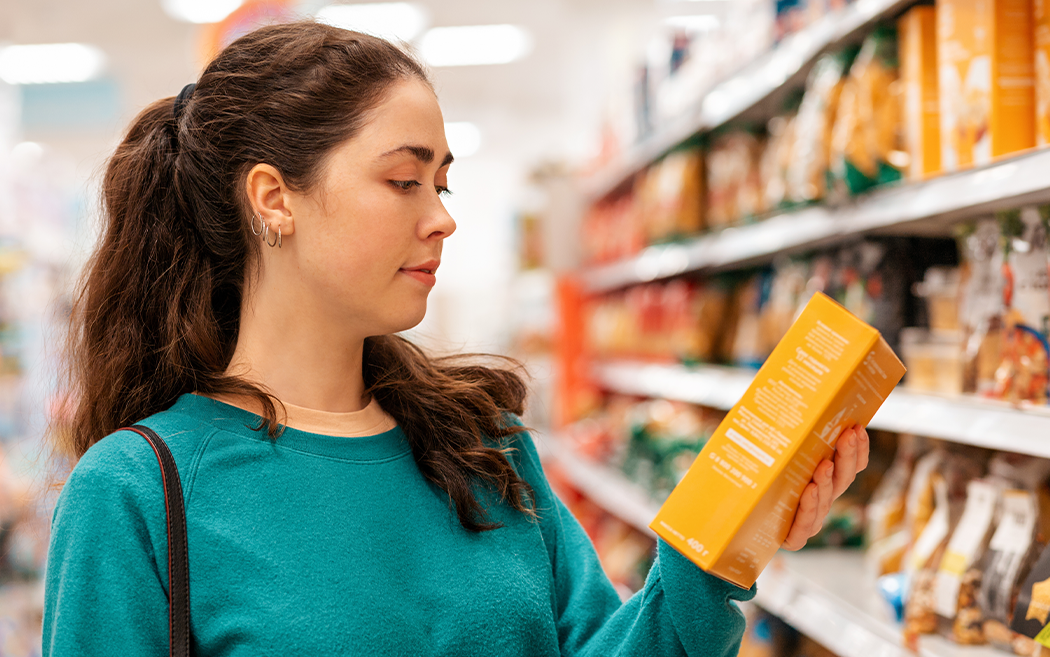Time for a Packaging Refresh? Here’s What Food & Beverage Brands Should Consider

Updating packaging is a routine part of CPG marketing. Learn when brands need to refresh packaging plus what to keep in mind before getting started.
Brand packaging is usually a customer’s first impression of a product. Regardless of whether they’re seeing it online or in-store, the wrapping or container is a key touchpoint for conveying brand identity, differentiating a product, and creating positive customer experiences.
That being said, package designs need to be updated regularly to adapt to changing consumer values and habits.
When Should A Brand Refresh Its Packaging?
The general consensus is that brands should prepare for a packaging refresh every five years. That means beverage and food marketing teams should routinely analyze the efficacy of packaging and decide what changes should be made.
This helps products avoid several pitfalls. First, regardless of the expiration date, old or stale packaging can make consumers think of old food which is undesirable. Second, packaging that hasn’t been updated in some time can start to blend into the background. Even small changes to packaging can help draw eyes to a product.
There are other circumstances, however, that may prompt a brand to redesign their packaging sooner. For example, if consumers have provided negative feedback (via social media, research data, etc.) in regard to packaging, then it’s safe to say that it’s time for a packaging refresh.
Things like shifting product categories and flat sales are also good reasons to alter packaging. Additionally, when a competitor updates their packaging, it may be a good time to do so as well. Conversely, when a competitor hasn’t updated their packaging in some time, a packaging refresh is an opportunity to stand out.
CPG Marketing Trends to Consider Before a Packaging Refresh
Before overhauling a product’s packaging, there are several items a brand should take into consideration. CPG marketing trends have drastically changed over the last few years. So, some of the strategies that worked in the past may not be as successful today.
First, even legacy brands should regularly analyze consumer values. The things that consumers care about can change from year to year, so any brand that doesn’t adapt may lose market shares to brands that speak directly to those values.
If consumers are concerned with sustainability or social issues, brands might consider copy that addresses these values or perhaps even environmentally friendly packaging materials. For consumers looking for the best-tasting products, displaying food awards will provide the necessary substantiation for those types of ad claims.
It’s also important to consider consumer buying habits when redesigning packaging. Omnichannel marketing means that packaging needs to convey all the right information in several different channels. Whether that’s a brand’s website, social media, and/or in-store, the packaging should be equally effective in all areas.
Make the Most of Packaging Space
While it may be tempting to cram as much information as possible onto packaging, strategically utilizing space will be far more effective.
For example, white space or negative space can be used to create a clean, modern design. Plus, the lack of clutter can draw consumers’ eyes to specific areas.
Even if a brand forgoes the modern look in favor of a “more is more” approach, a balance of graphics and copy can still convey important information. Review the various messages that the packaging needs to convey and then consider whether each message would be best conveyed via text or images.
For example, displaying food awards like the ChefsBest Excellence Award is a symbolic image that helps reinforce the taste and quality messaging a food or beverage brand is communicating.
Conversely, sometimes copy is necessary to create emphasis. For example, if consumers prefer gluten-free products, simply displaying the Certified Gluten Free symbol might not draw enough attention to this feature. In that case, additional copy that speaks to that idea may be more effective.
Balance the Original Brand Image With Needing to Stand Out
Finally, it’s essential to balance new packaging ideas with the original brand image. Yes, the goal is to create packaging that stands out and draws in new customers. However, that shouldn’t come at the cost of losing brand recognition from current customers.
Marketing, and food marketing in particular, is effective when it creates a consistent brand image or story. It’s about creating something that consumers recognize, remember, and trust. Regardless of why a brand has chosen to refresh their packaging, new packaging should speak to current and new customers.
That being said, sometimes the best alterations are small. Something as simple as updating typography or colors can create a fresh brand personality. Additionally, drawing attention to any new features, like quality food awards or sustainable packaging, can provide added value and product differentiation without sacrificing recognition.
Want insight from an expert in the industry? Tune in to How to Create Branding Your Customers Will Love. In this episode of our podcast, Beyond the Shelf, Ross Kimbarovsky talks about how Crowdspring gives brands the opportunity to choose between different designs while fostering collaborative and efficient workflows. As an added bonus, Ross shares common marketing and branding pitfalls to avoid.
To stay up-to-date with trends and news in the food & beverage industry, follow us on social media: Facebook, Twitter, Instagram, and LinkedIn – and check out more of our blogs.
